Topics
Reproduction in Lower and Higher Plants
- Reproduction
- Mode of Reproduction in Plant
- Asexual Reproduction in Plant
- Vegetative Reproduction
- Natural Vegetative Reproduction
- Artificial Vegetative Reproduction
- Sexual Reproduction in Flowering Plants
- Pre-fertilization in Plant: Structure and Events
- Pre-fertilization in Plant: Stamen (Male Reproductive Unit)
- Pre-fertilization in Plant: Microsporangium
- Structure of Microspore Or Pollen Grain
- Pre-fertilization in Plant: Pistil (Female Reproductive Unit)
- Pre-fertilization in Plant: Megasporangium
- Pre-fertilization in Plant: Formation of Embryo Sac
- Pollination
- Self Pollination (Autogamy)
- Cross Pollination
- Agents of Pollination
- Outbreeding Devices
- Pollen Pistil Interaction
- Fertilization Process
- Post Fertilisation in Plant: Structures and Events
- Development of Endosperm
- Post Fertilization in Plant: Development of Embryo (Embryogeny)
- Formation of Seed and Fruit
- Apomixis
- Parthenocarpy
- Polyembryony
- Kinds of Pollination
Reproduction in Lower and Higher Animals
- Reproduction
- Mode of Reproduction in Animal
- Asexual Reproduction in Animal
- Sexual Reproduction in Animals
- Human Reproduction
- The Male Reproductive System
- The Female Reproductive System
- Menstrual Cycle (Ovarian Cycle)
- Gametogenesis
- Fertilization in Human
- Embryonic Development in Human
- Implantation in Human
- Pregnancy in Humans
- Placenta (Growth) in Human
- Parturition (Birth) in Human
- Lactation in Human
- Reproductive Health
- Population Stabilisation and Birth Control
- Medical Termination of Pregnancy (MTP)
- Sexually Transmitted Diseases (STD)
- Infertility
- Gastrulation in humans
Inheritance and Variation
- Heredity or Inheritance
- Gregor Johann Mendel – Father of Genetics
- Genes and Genetic
- Mendelian Inheritance - Mendel’s Law of Heredity
- Back Cross and Test Cross
- Deviations from Mendel’s Findings
- Chromosomal Theory of Inheritance
- Chromosomes - The Carriers of Heredity
- Linkage and Crossing Over
- Autosomal Inheritance
- Sex Linked Inheritance
- Sex Determination
- Genetic Disorders
Molecular Basis of Inheritance
- Deoxyribonucleic Acid (DNA) and Its Structure
- The Genetic Material is a DNA
- Packaging of DNA Helix
- DNA Replication
- Protein Synthesis
- Regulation of Gene Expression
- Operon Concept
- Genomics
- Human Genome Project
- DNA Fingerprinting Technique
- Genetic Code
Origin and Evolution of Life
- Origin and Evolution of Universe and Earth
- Theories of Origin of Life
- Chemical Evolution of Life (Self-assembly Theory of the Origin of Life)
- Darwinism
- Mutation Theory
- Modern Synthetic Theory of Evolution
- Organic Evolution
- Hardy Weinberg’s Principle
- Adaptive Radiation
- Evidences for Biological Evolution
- Speciation
- Geological Time Scale
- Human Evolution
- Theories of Biological Evolution
Plant Water Relation
- Plant Water Relation
- Properties of Water
- Water absorbing organ
- Water Available to Roots for Absorption
- Means of Transport in Plants
- Concept of Imbibition
- Simple Diffusion
- Concept of Osmosis
- Osmotic Pressure
- Facilitated Diffusion
- Turgidity and Flaccidity (Plasmolysis)
- Active Transport
- Passive Transport
- Water Potential (ψ)
- Path of Water Across the Root
- Translocation of Water (Ascent of Sap)
- Transport of Mineral Ions
- Transport of Food
- Transpiration
- Types of Transpiration
- Structure of Stomatal Apparatus
- Significance of Transpiration
Plant Growth and Mineral Nutrition
- Plant Growth
- Phases of Plant Growth
- Conditions Necessary for Plant Growth
- Plant Growth Rate
- Plant Growth Curve
- Differentiation, De-differentiation, Re- Differentiation
- Plant Development
- Plant Plasticity
- Plant Hormones
- Types of Plant Hormones: Auxins
- Types of Plant Hormones: Gibberellins
- Types of Plant Hormones: Cytokinins
- Types of Plant Hormones: Ethylene
- Types of Plant Hormones: Abscisic Acid (ABA)
- Photoperiodism
- Vernalization (Yarovization)
- Plant Mineral Nutrition
- Nitrogen Cycle
Respiration and Circulation
- Respiration
- Organs of Respiratory Exchange
- Human Respiratory System
- Mechanism of respiration-Breathing
- Regulation of Breathing / Respiration
- Modified Respiratory Movements
- Disorders of Respiratory System
- Transportation in Living Organisms
- Circulation in Animals
- Types of Closed Circulation
- Blood Circulatory System in Human
- Composition of Blood: Plasma (The Liquid Portion of Blood)
- Composition of Blood: Red Blood Cells (Erythrocytes)
- Composition of Blood: White Blood Cells (Leukocytes)
- Composition of Blood: Blood Platelets (Thrombocytes)
- Function of Platelets - Clotting of Blood (Coagulation)
- Human Heart
- Working mechanism of human heart
- Blood Vessels
- Blood Pressure (B.P.)
- Electrocardiogram (ECG)
- Lymph and Lymphatic System
- Mechanism of respiration - Internal respiration
- Mechanism of respiration - External respiration
- Mechanism of respiration - Cellular respiration
Control and Co-ordination
- Control and Co-ordination
- Nervous System in Hydra
- Nervous System in Planaria (Flatworm)
- Neural Tissue
- Neuron (Or Nerve Cell) and Its Types
- Neuroglial Cells (Or Glial Cells)
- Human Nervous System
- Central Nervous System (CNS)
- The Human Brain - Forebrain
- The Spinal Cord
- Peripheral Nervous System (PNS)
- Sensory Receptors
- Human Eye
- Human Ear
- Disorders of Nervous System
- Chemical Coordination
- Human Endocrine System
- The Hypothalamus
- Pituitary Gland or Hypophysis Gland
- The Pineal Gland
- Thyroid Gland
- Parathyroid Gland
- Thymus Gland
- Adrenal Gland (Suprarenal Gland)
- Pancreas (Islets of Langerhans)
- Reproductive Glands (Gonads)
- Synapse - Properties of nerve fibres
- Synapse - Types of synapse
- Transmission of nerve impulse
- Generation of nerve impulse
- Reflex Action
- Autonomic Nervous System (ANS)
- Diffuse Endocrine Glands
Human Health and Diseases
- Defence System in Our Body: Immune System
- Immunity
- Types of Immunity
- Vaccination and Immunization
- Structure of Antibody
- Disease
- Protozoan Diseases
- Helminthic Diseases
- Bacterial Diseases
- Viral Diseases
- Fungal Diseases
- Vector Borne Diseases
- Cancer
- Adolescence
- Addiction
- Drug Abuse
Enhancement of Food Production
- Improvement in Food Production
- Plant Breeding
- Tissue Culture
- Single Cell Protein (SCP)
- Biofortification
- Animal Husbandry (Livestock)
- Animal Breeding
- Dairy Farming
- Poultry Farming
- Apiculture (Bee Farming)
- Pisciculture (Fish Farming)
- Sericulture
- Lac Culture
- Microbes in Human Welfare
- Microbes in Industrial Production
- Microbes in Sewage Treatment
- Microbes in Energy Generation
- Microbes as Biocontrol Agents
- Microbes as Biofertilizers
Biotechnology
- Biotechnology
- Process and Principles of Biotechnology
- Methodology for rDNA Technology
- Commercial Applications of Biotechnology
- Bioethics
- Effects of Biotechnology on the Environment
- Biopatent and Biopiracy
- Transgenic Plants
- Transgenic animals
- Effects of Biotechnology on Human Health
- Tools and techniques for gene cloning/ rDNA technology
Organisms and Populations
- Organisms and the Environment Around
- Habitat
- Niche
- Structure and function of an Ecosystem
- Adaptations and Its Types
- Population
- Population Interactions
- Organisms and Populations
Ecosystems and Energy Flow
- Ecosystem
- Structure and function of an Ecosystem
- Concept of Energy Flow in an Ecosystem
- Classification of Animal
- Trophic Level
- Food Chain
- Food Web
- Ecological Pyramids
- Nutrient Cycles
- Ecological Succession
- Ecosystem Services
- Productivity
- Decomposition
- Phosphorus Cycle
- Carbon Cycle
Biodiversity, Conservation and Environmental Issues
- Biodiversity
- Levels of Biodiversity
- Patterns of Biodiversity
- Biodiversity Current Scenario
- Loss of Biodiversity
- Conservation of Wildlife
- Biological Diversity Act, 2002
- Environmental Issues
- Air Pollution and Its Causes
- Noise Pollution
- Water Pollution and Its Causes
- Green House Effect
- Preventive Measures of Green House Effect
- Global Warming
- Preventive Measures of Global Warming
- Ozone Layer Depletion
- Deforestation and Its Causes
- Mission Harit Maharashtra
- Conservation of Biodiversity
Excretion and Osmoregulation
- Modes of Excretion: Ammonotelism, Ureotelism, and Uricotelism
- Human Excretory System
- Function of the Kidney - “Production of Urine”
- Regulation of Kidney Function
- Common Disorders of the Urinary System
Human Reproduction
- Population stabilisation and birth control
- Contraceptive methods
- Temporary method:
a. Natural method/ Safe period / Rhythm method
b. Coitus Interruptus or withdrawal
c. Lactational amenorrhea (absence of menstruation)
d. Chemical means (spermicides)
e. Mechanical means / Barrier methods
f. Physiological (Oral) Devices - Permanent Methods
Notes
Birth control measures:
- The birth control measures which deliberately prevent fertilization are referred to as contraceptives.
- The contraceptive methods help to prevent unwanted pregnancies. An ideal contraceptive should be easily available, user friendly, effective and with no or least side effects.
- Statutory raising of the marriageable age of the female to 18 years and that of males to 21 years.
- Small-family couples should be offered some incentives.
- Aware people about the slogan of “Hum Do Hamare Do”.
- Many couples, mostly the young, urban, working ones have even adopted a ‘one child norm’.
- Birth control is an important step toward population control since it encourages smaller families to use contraceptive techniques.
Contraceptive methods:
- An ideal contraceptive should be simple to use, easily accessible, effective, and reversible, with no or few negative effects.
- It should also not interfere with the user's sexual drive, desire, or sexual deed.
- There are numerous contraceptive techniques available today, which can be broadly classified as Natural/Traditional, Barrier, IUDs, Oral contraceptives, Injectables, Implants, and Surgical procedures.
-
Natural/Traditional methods: Natural approaches are based on the premise of minimizing the possibility of ovum and sperm contact. In this method of birth control, the side effects are almost nil and the chances of failure are high.
a) Period abstinence: Periodic abstinence is one such strategy in which couples avoid or abstain from coitus between days 10 and 17 of the menstrual cycle when ovulation is predicted. The fertile period is so named because the possibilities of fertilization are so great during this time. As a result, by abstaining from coitus during this time, conception could be avoided.
b) Withdrawal or coitus interrupts: Another approach is withdrawal, or coitus interruptus, in which the male partner withdraws his penis from the vagina immediately before ejaculation to avoid fertilization.
c) Lactational amenorrhea: The lactational amenorrhea (absence of menstruation) technique is based on the fact that ovulation and hence the cycle do not occur during the postpartum phase of strong lactation. Fully breastfeeding increases lactation. This method helps to prevent conception. This is effective up to 6 months following parturition. Because no medications or equipment are used in these approaches, negative effects are virtually non-existent. This approach, however, has a significant failure rate. -
Barrier methods:
Ovum and sperms are prevented from physically meeting with the help of barriers and it is also available for both males and females.
a) Condoms: Condoms are mechanical barriers made of thin rubber or latex sheath to cover the penis in males or vaginas and cervix in females which prevent the meeting of sperm and ova. Condoms also provide protection against sexually transmitted diseases. They are disposable and can be self-inserted and thereby giving privacy to the user.
Condom for male
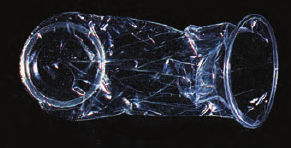
Condom for female
b) Diaphragms, cervical caps, and vaults: Diaphragms, cervical caps, and vaults are also rubber barriers put into the female reproductive tract to shield the cervix during coitus. They hinder pregnancy by preventing sperm entrance via the cervix. They can be reused. Spermicidal lotions, jellies, and foams are commonly used in conjunction with these barriers to improve their contraceptive effectiveness.

c) Intra Uterine Devices (IUDs): Intra Uterine devices are inserted by doctors or expert nurses in the uterus through the vagina. These Intra Uterine Devices are presently available as the non-medicated IUDs (e.g., Lippes loop), copper releasing IUDs (CuT, Cu7, Multiload 375), and hormone releasing IUDs (Progestasert, LNG-20). IUDs increase phagocytosis of sperms within the uterus and the Cu ions released suppress sperm motility and the fertilizing capacity of sperms. The hormone releasing IUDs, in addition, make the uterus unsuitable for implantation and the cervix hostile to the sperms. IUDs are ideal contraceptives for females who want to delay pregnancy and/or space children. It is one of the most widely accepted methods of contraception in India.
i) Non-medicated IUDs: Non-medicated IUDs retards sperm mortality. Also, have a spermicidal effect. Example - Lippes's loop
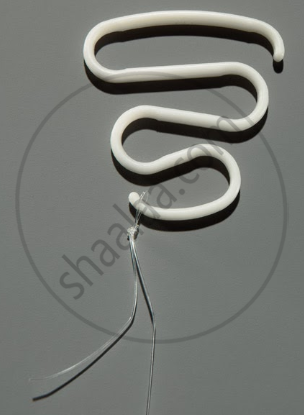
Lippes's loop
ii) Copper releasing IUDs: Copper releasing IUDs suppress mortality and fertilizing capacity of sperms. Examples - CuT, Cu7, Multiload 375.
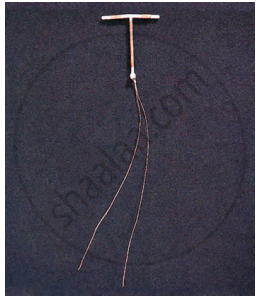
Copper T (CuT)
iii) Hormone-releasing IUDs: Hormone-releasing IUDs are currently available. They make the uterus unsuitable for implantation and the cervix hostile to the sperms. Examples - Progestasert, LNG-20.
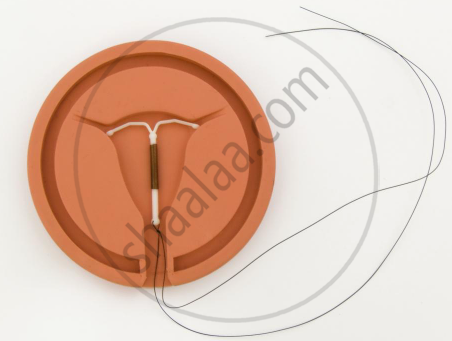
Hormone-releasing IUDs
- Chemical methods:
a) Oral contraceptives: Females also employ oral administration of tiny dosages of progestogens or progestogen–estrogen combos as a contraceptive technique. They are commonly referred to as pills since they are administered in the shape of tablets. Pills must be taken daily for 21 days, particularly within the first five days of the menstrual cycle. After a 7-day break (during which menstruation occurs), the process must be repeated until the female chooses to avoid conception. They hinder or delay sperm entry by inhibiting ovulation and implantation and altering the quality of cervical mucus. Pills are quite effective, have few adverse effects, and are well accepted by E.g., Saheli–the new oral contraceptive for females contains a non-steroidal preparation. It is a ‘once a week’ pill with very few side effects and a high contraceptive value.
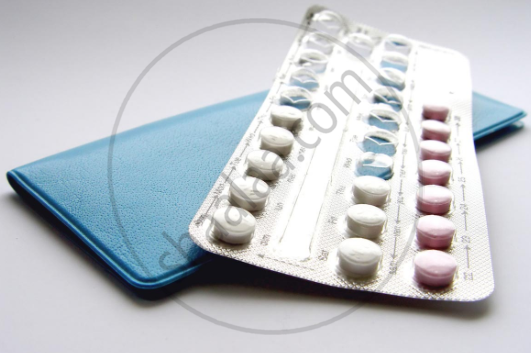
Oral contraceptive pills
b) Injectables and Implants: Females can utilize progestogens alone or in combination with oestrogen as injections or skin implants. Their mechanism of action is similar to that of pills, but their effective periods are significantly longer. Progestogens, progestogen-estrogen combos, or IUDs administered within 72 hours following coitus have been found to be particularly successful as emergency contraceptives, as they can be used to avoid possible pregnancy due to rape or casual unprotected intercourse.

Implants
- Surgical Methods (Sterilization): Surgical intervention stops gamete transit, preventing conception. Very effective but reversibility is very poor.
a) Vasectomy: Sterilization procedure in males. In vasectomy, a small part of the vas
deferens is removed or tied up through a small incision on the scrotum.
b) Tubectomy: Sterilization procedure in females. In this, a small part of the fallopian tube is removed or tied up through a small incision in the abdomen or through the vagina.
Vasectomy
It should be emphasised that choosing a proper contraceptive method and using it should always be done in conjunction with trained medical specialists. It is also important to realise that contraception is not a regular requirement for maintaining reproductive health. In fact, they are used to counteract a natural reproductive occurrence, namely conception/pregnancy. Due to personal circumstances, one is forced to adopt these treatments either to prevent pregnancy or to delay or space pregnancy.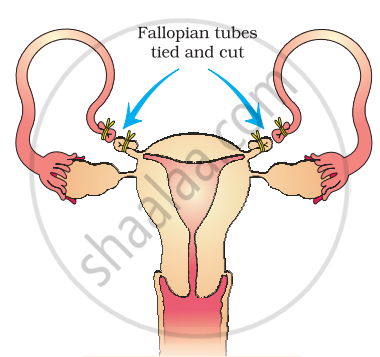
Tubectomy
Side effects of anti-natural contraceptives: Nausea, abdominal pain, breakthrough bleeding, irregular menstrual bleeding, Breast Cancer, etc. Though not very significant, should not be totally ignored.

